I had never been crazy about croissants until the day I first made them using the recipe from Chad Robertson's famous Tartine Bread book. There are many recipes out there that show you how to make croissants, but this Tartine croissant recipe is truly special.

The croissants that came out of my oven truly surprised me, in many ways. Full bodied and plump, they displayed a range of beautiful colors from light creamy yellow to shiny rich brown. The freshly baked bread aroma with hints of butter and buttermilk was mouthwatering. I couldn't wait to try one. I let them cool down for a few minutes and dug in.
The crust was thin and wonderfully crispy, in contrast to soft, flaky and buttery crumb. Moist and pleasantly chewy, the crumb was a happy medium between dense naturally leavened bread crumb and overly aerated bread crumb leavened with commercial bread yeast.
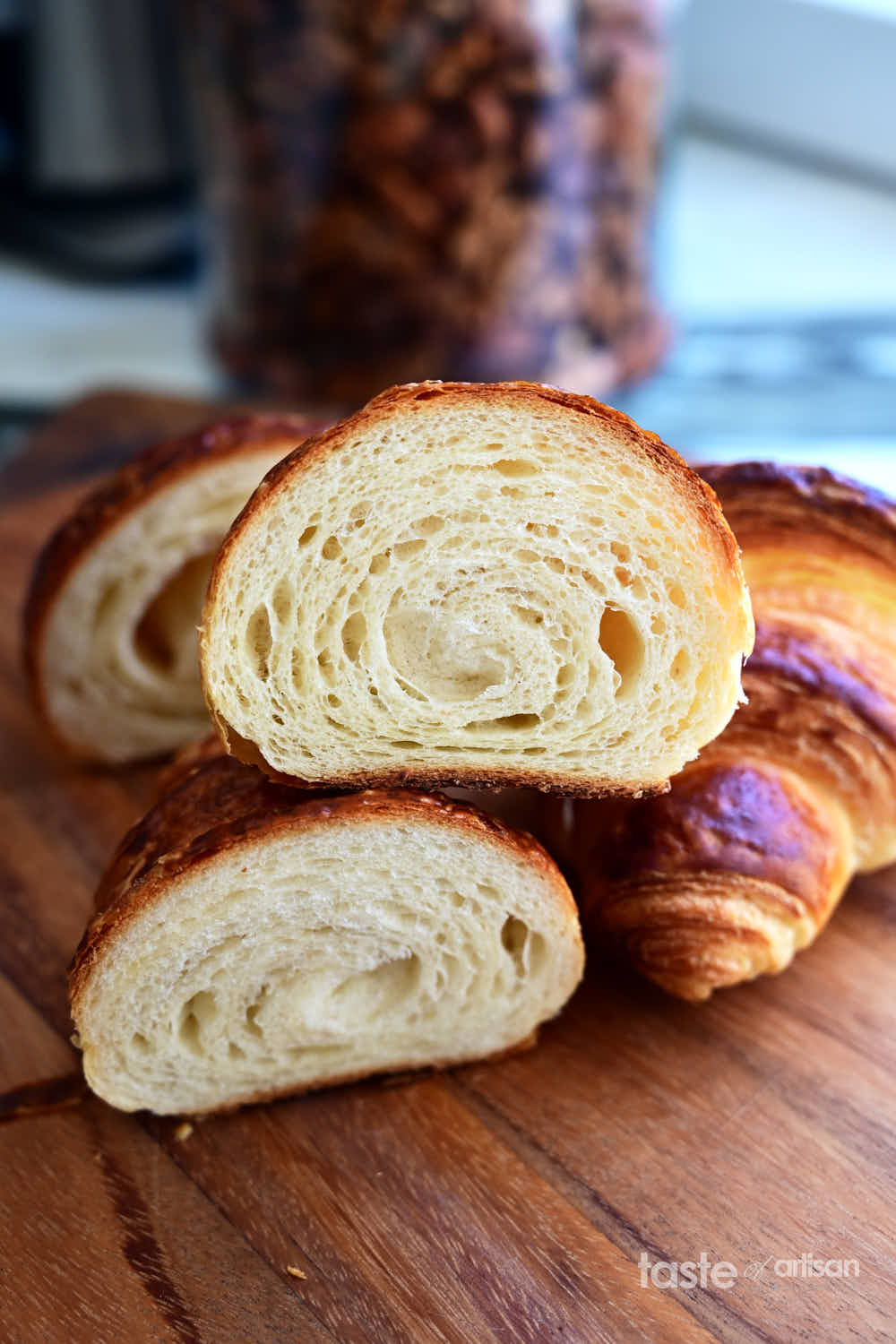
It had slight sweetness, just a touch, finding a perfect balance with salt. Just a hint of sourness from sourdough starter was present, not overpowering, lending the crumb a pleasant light buttermilk-y taste. It felt like putting jam or cream cheese on this croissant would be sacrilege. It was perfect on its own.
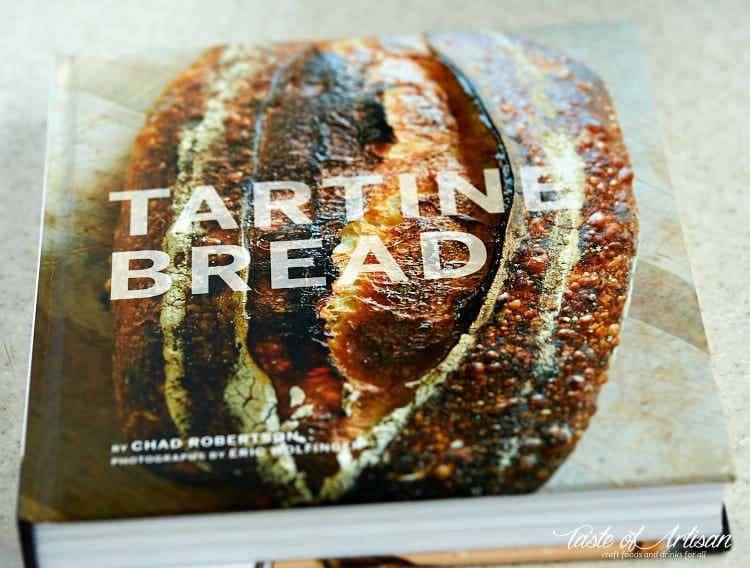
Making Tartine croissants no doubt is a lengthy process, but totally worth it. Actually, it is the lengthy fermentation process using pre-fermented poolish and natural leaven (sourdough starter) that gives them complex flavors and exceptional keeping qualities. Days after baking, they still remain fresh and moist inside. You may want to warm them up in a microwave oven to get the best taste.
While being lengthy, the basic process for making Tartine croissants is quite simple. You start off with preparing poolish and leaven. Poolish is a mix of flour, water and commercial dry yeast that is fermented for about 3-4 hours at room temperature, or overnight in the fridge. Leaven is a mix of flour, water and a tablespoon of mature sourdough starter that is fermented overnight at room temperature. They are ready when they are about doubled in volume and bubbly.
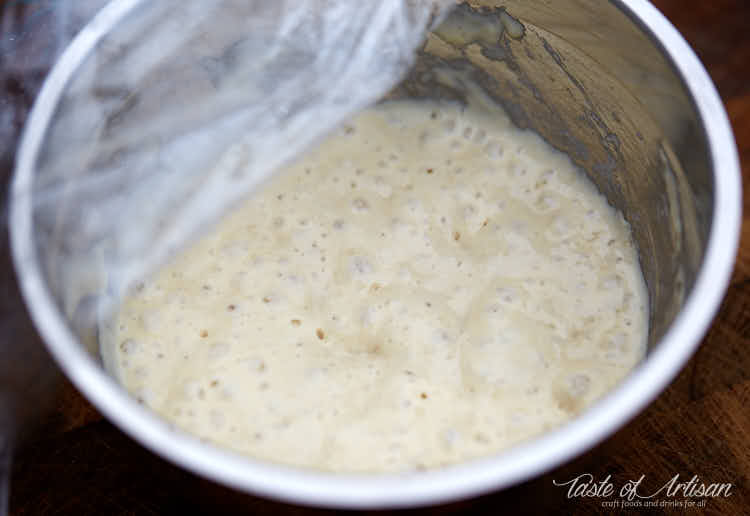
Once your your pre-ferments (poolish and leaven) are ready, mix them with warm milk. After poolish and leaven are fully dispersed in milk, add the rest of the ingredients, cover with plastic wrap and let sit for about half an hour. After that, knead slightly and let rise at warm room temperature for 1 1/2 hours, while doing stretch and folds every 30 minutes. Stretch and fold technique helps the dough develop gluten and strengthen. The technique is very simple - in the bowl, pull one corner of the dough and fold onto itself. Repeat for the rest of the three corners and then flip the dough upside down. This dough will be fairly stiff, so you may want to hold it with one hand while stretching and folding with the other.
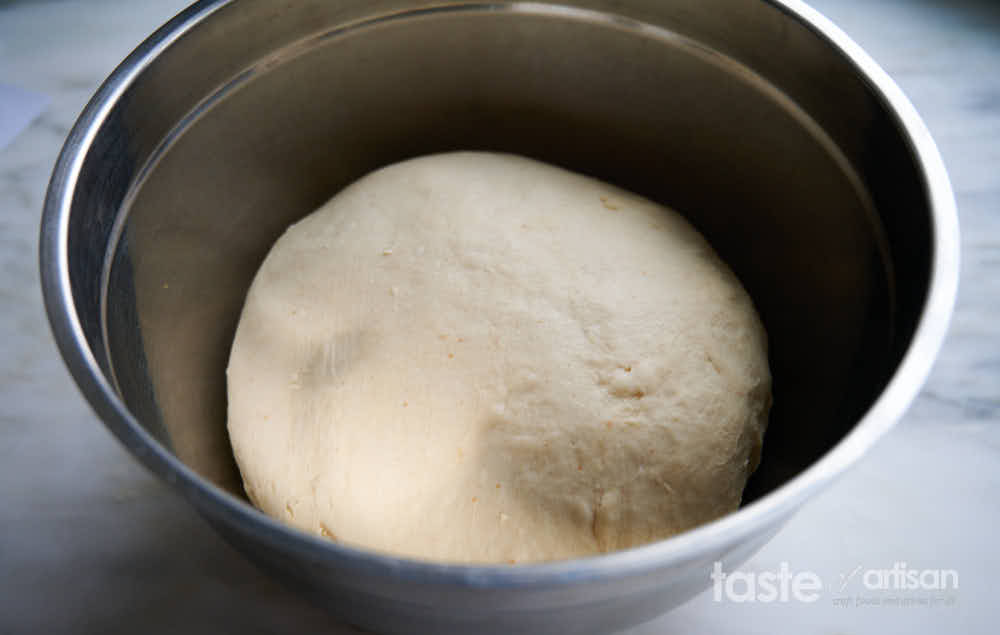
After that, wrap the dough in saran wrap, flatten and refrigerate for 2-3 hours. Just before taking it out, prepare you butter block. We will need it for lamination. Lamination is a process creating alternating thin layers of dough and butter. This is what gives croissants buttery and flaky texture. Butter block should measure about 8 x 12 inches. I find it easier to prepare an envelope of this size from parchment paper, place butter and flour inside and close it, and then mold the butter block with a rolling pin. This way you will get even thickness and the desired size of the block.
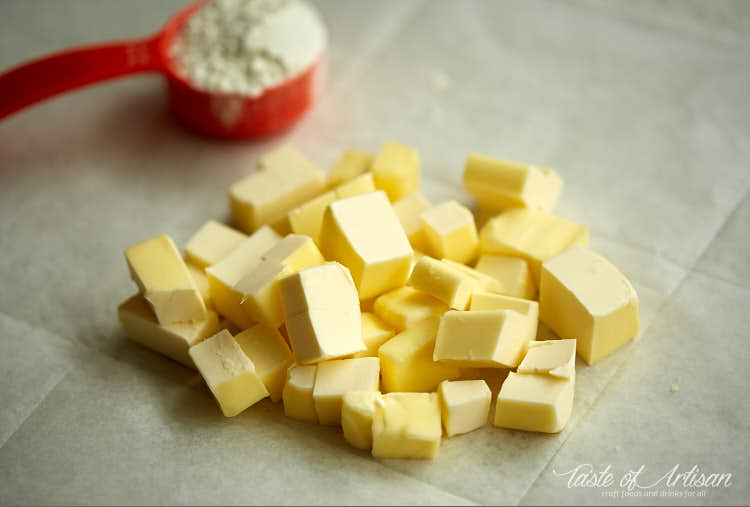
When molding, be sure not to pound too hard or the parchment paper will break, in which case you will most likely have to make a new envelope. I usually use light pounding, pressing and rolling to mold the butter. Be sure to work quickly as you don't want the butter to warm up and become soft and runny. We want to achieve cold but pliable butter block, which should have about the same hardness and consistency as your chilled dough. If it becomes too soft, chill in the fridge for 15-20 minutes and then mold again.
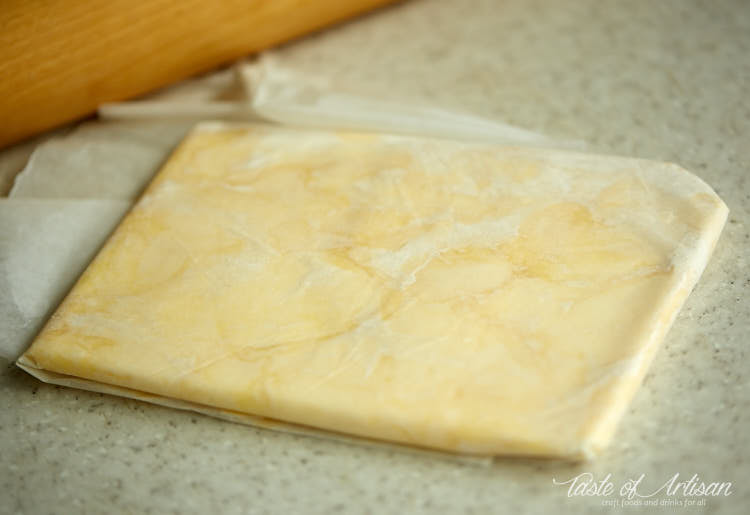
Roll the dough out to about 12 by 20 inches rectangle. Place the butter block on the dough rectangle, aligning it to the right. It should cover 2/3 of the dough surface.
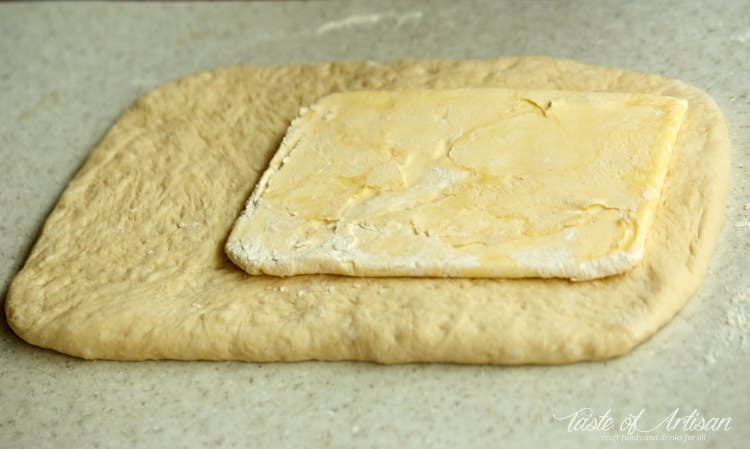
Now fold the dough as you would fold a letter.
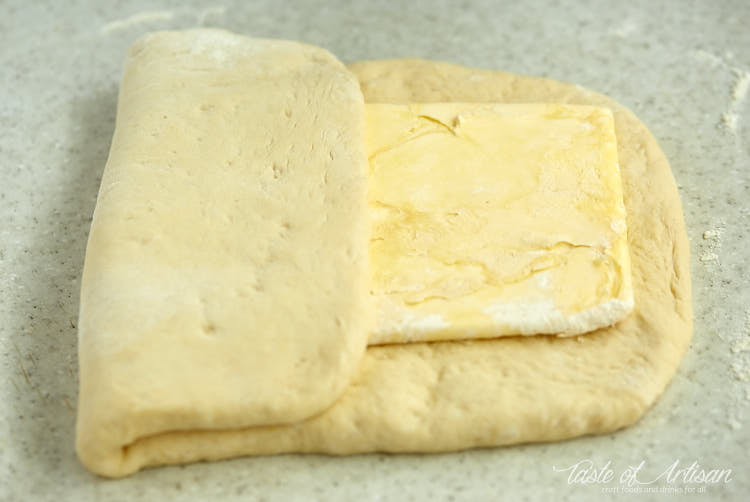
Immediately rotate the dough 90 degrees and again roll it out to 12 by 20 inches rectangle, and do another letter fold.

Cover with saran wrap and refrigerate for an hour. After that you want to, again, roll out the dough to a 12 by 20 inches rectangle, do letter fold and refrigerate. This will be your second fold. Repeat one more time and you are done. 3 folds altogether.
After the third fold, I usually put the dough back in the fridge for half an hour to relax, then roll it out to about 12 by 24 inches rectangle. The size of the rectangle may vary, depending several factors such as how much your dough has risen, but you want to make sure that the thickness is 1/2 inch. At this point I usually let the rolled-out dough sit for about 10 minutes to relax, otherwise, it will pull together and shrink a bit when you cut it. Nothing wrong with that, only the croissants will turn out shorter and stubbier. Cut the dough in half horizontally, and then cut vertically into 3-4 equal parts. Then cut each of the smaller rectangles in half on the diagonal.
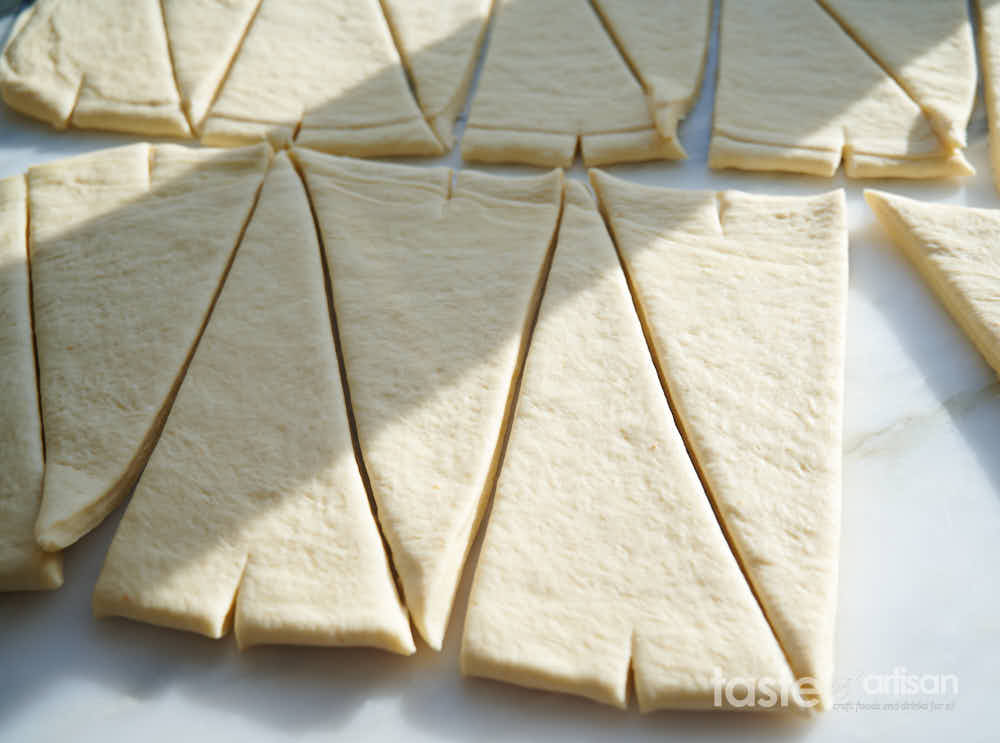
Now roll up each triangle, starting with the wide end, and making sure that the narrow end ends up on the bottom. This will prevent croissants from unrolling when they expand during baking.

Place rolled-up croissants on parchment paper-lined baking sheets, spaced about 1.5 - 2 inches, cover with plastic and let rise at room temperature for about 2 hours. Croissants will rise by about 50% during this time. Brush with egg wash.
Bake at 425F for about 20-30 minutes until deep golden brown. Smaller size croissants will require less baking, so you may want to keep an eye on them at 15 minutes to check if they are ready.
This Tartine croissant recipe is adapted from Chad Robertson's Tartine Bread book.


Ingredients
- 15 oz milk whole or 2%; about 450 g
- 10 oz leaven about 300 g
- 13 1/3 oz poolish about 400 g
- 2 3/16 lbs bread flour about 1000 g
- 5 tsp salt about 28 g
- 6 Tbsp sugar about 85 g
- 2 tsp active dry yeast about 10 g
For dough lamination
- 14 oz unsalted butter cold, 400 g or 3.5 sticks
- 1/2 cup flour
For the egg wash
- 2 large egg yolks
- 1 tsp heavy cream or milk
Instructions
- Have your poolish and leaven ready before you begin.
- Bring milk to room temperature. In a big bowl, add polish and leaven to milk and stir.
- Mix in the rest of the ingredients. Cover with saran wrap and let stand for half an hour.
- Knead the dough for 5-10 seconds, cover and let ferment at room temperature for 1.5 hours, doing stretch and folds every half an hour. Stretch and fold is basically taking a corner of the dough, stretching and folding onto itself. Done once for each corner at a time.
- Transfer the dough into a plastic bag, flatten it into a rectangle, and refrigerate for 2-3 hours.
- Mold the butter and 1/2 cup of flour into a 8 x 12 inches rectangle. Do it quickly not letting the butter warm up. I use a pre-shaped envelope made from parchment paper for this task. I cut butter into small cubes, mix with flour, and place into the parchment paper envelope. Then, using a rolling pin, I pound, press and roll it to mold it into a rectangle. Put in the fridge.
- Take out the dough from the fridge and roll out into a 12 x 20 inches rectangle.
- Take out the block of butter from the fridge and lay it horizontally on the dough. It should cover about 2/3 of the length of the dough.
- Fold the left and the right side of the dough as you would fold a letter. Turn the dough 90 degrees and roll it out into a rectangle measuring about 12 x 20 inches. Do the fold again, cover with saran wrap and refrigerate for 1 hour.
- Take the dough out of the fridge, roll out to a 12 x 20 inch rectangle and fold. This is the second turn.
- Refrigerate for 1 hour and do a third turn. If you want to use the dough later, place it into a freezer proof bag and freeze for up to three days. The night before using the dough, transfer it into refrigerator.
- After the third turn, if using immediately, let the dough relax in the fridge for half an hour, then take out and roll out to 12 x 24 inches rectangle. The dough should be about 1/2 inch thick.
- Using a pizza cutter, cut the dough in half, horizontally. Then cut vertically into about 3 or 4 equal pieces. Then cut each piece in half diagonally into triangles.
- Roll up each triangle, beginning at the widest side, and placing the narrow end on the bottom.
- Place rolled up pieces onto a parchment paper lined baking sheet, cover with plastic wrap and let sit at room temperature for about 2 hours. Croissants should increase in size by about 1.5 times.
- Preheat oven to 425 F.
- Prepare egg wash by whisking briskly egg yolks and cream or milk. Brush the tops of croissant with the egg wash.
- Bake for about 20-30 minutes , until the croissants are deep golden brown, crisp and flaky. Smaller size croissants may take 15 minutes to bake, so keep an eye on them, especially the first time you are making them.
Notes
Leaven:1 Tbsp mature sourdough starter220 g all-purpose flour220 g water (80F)Mix flour, water and sourdough starter in a bowl, cover and let stand overnight at room temperature.
Nutrition


Jackie says
How to prepare the levain and polish for tartine croissant?
Jackie G says
Hi, I just saw the recipe for those in the notes section.
Victor @ Taste of Artisan says
Must have missed your comment. Yes, those are in the notes section. Happy baking!
Cris says
And if I don’t have mature sourdough starter?
Victor @ Taste of Artisan says
No croissant for you then:) On a serious note, I haven't tried this, but I would substitute it for poolish. You won't get the same depth of flavor but it will be good.
Taylor says
Can I make the dough ahead of time? Say on Friday, then roll out, proof and bake on Sunday?
Victor @ Taste of Artisan says
I've retarded the final rise in the fridge overnight, it worked well. I suppose you can do what you propose as well, I sometimes retard my baguette dough for two days, then shape and proof in the morning. Should be fine. Just make sure that the fridge is cold enough or else the dough will over ferment.
Andria Porter says
I have to thank you for the efforts you have put in penning this site. I'm hoping to see the same high-grade blog posts from you later on as well. In truth, your creative writing abilities has inspired me to get my own website now 😉
Victor @ Taste of Artisan says
Thank you and good luck with your website.
Jocelyn says
Why so little love for Tartine croissants? LOL This is one of my favorite croissant recipes, I've been making them for years. These aren't as rich and buttery as the classic croissants but that's why I like them. They are delicious.
Victor @ Taste of Artisan says
Glad you like them. My favorite too. Enjoy!
Beth Von Driska says
Did a test batch to understand poolish, leaven, and overall timing. I found dough kind of alarmingly stiff, and poured a small amount of water over dough before its 2 hour rise. By the time I did 3rd stretch, water had incorporated and dough was more in my comfort zone. Everything else went well. I was concerned about using all bread flour - there is such a wide range of flour types in croissant recipes - and these do have more substance and chew, but such great flavor. Also many recipes include the book turn as the last, and wondered if I should try it next time. Any thoughts on that? I like the idea that the sourdough quality may help them retain freshness. I'd rather bake at night than early morning. It's a very interesting recipe.
Victor @ Taste of Artisan says
Thanks for the feedback, Beth. Glad everything went well. Interesting that you had to add more water, I've never had to do that. Great flavor, I agree 100%. Including the book turn as the last - no harm in trying I think but I am no expert on this. What I do know is that there is no right or wrong in bread baking and I love experimenting. Happy baking!
P.S. I just posted my favorite Uzbek bread recipe. It's not a croissant but it's delicious. Lot's of flavor and substance. I think you may like it.
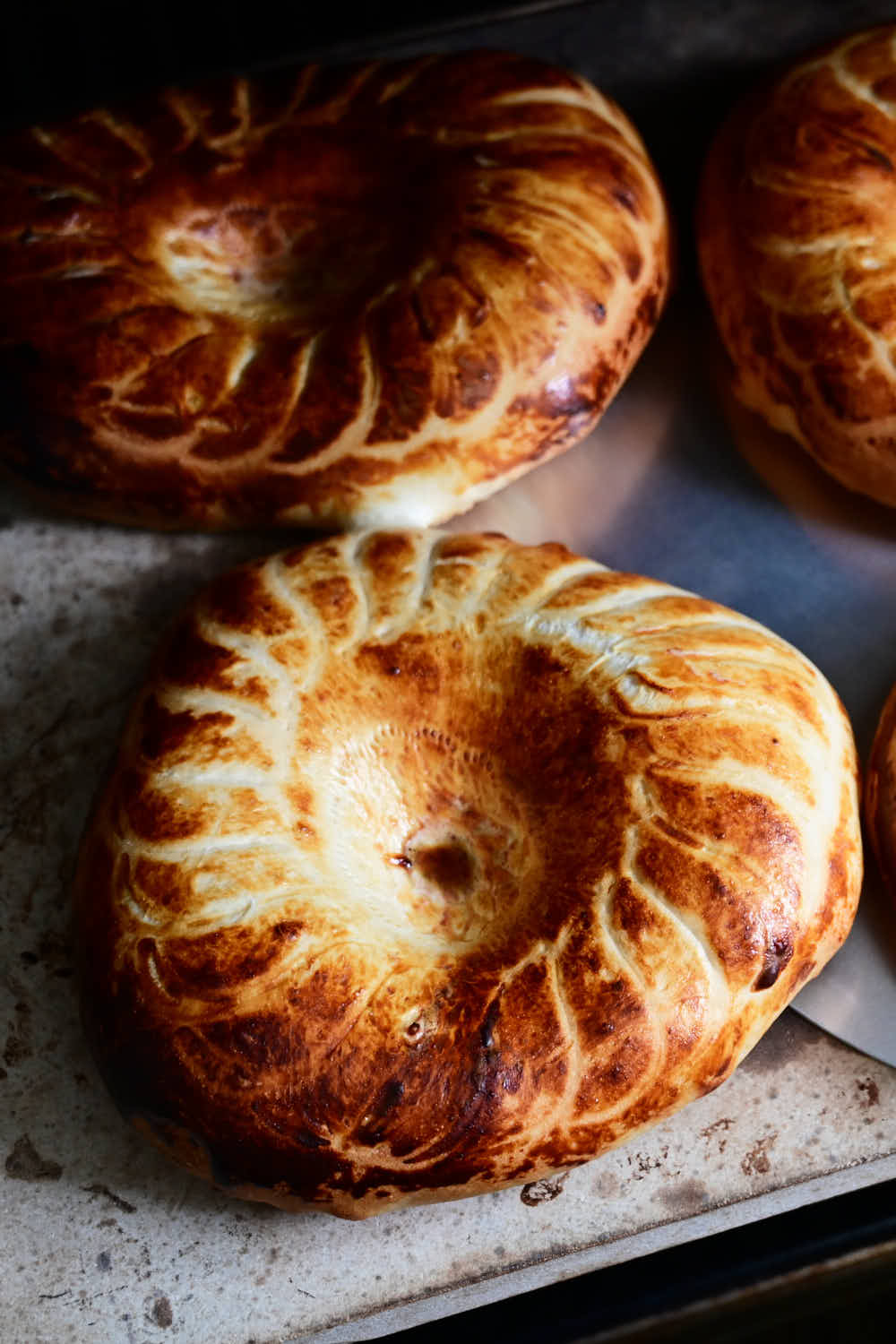
Liz says
Laughing about the larger croissant comments -- if you go to Tartine in San Francisco they are MASSIVE and it takes 45 minutes waiting in line to get your hands on one :P. The best are the chocolate filled croissants. I'm super excited to work on this recipe and try to recreate it/ improve my style! I left San Francisco and moved to Colorado and the croissant game is weak here.
Victor @ Taste of Artisan says
Liz, I think any and every croissant has the right to exist. I love Tartine croissants even though they don't look or feel/taste like classic croissants. Having only one kind of croissant is like having one tomato type. Boring.
Amanda says
Thank you for posting this recipe with your insights. I have the Tartine Bread book that has been well-loved, but as this recipe is quite the (well worth it) process, timing can be tricky, and I was off this time. Your replies to other comments gave me the reassurance I was looking for to put it in the freezer and then the fridge after the first turn to be finished the next day. It worked beautifully, thank you!
To those with comments bordering on complaints about the size, make them smaller! It's really that easy. This time around, after the initial cut halving the dough, I cut each half into a series of about 3-inch rectangles which I then cut diagonally to create my triangles. They made nice small croissants though I think next time, 4-inch cuts may be the perfect size.
I also made some almond paste that I rolled into half of them and then topped with sliced almonds. Delicious!!
Victor @ Taste of Artisan says
Thank you for your feedback, Amanda. Glad that you liked them. Happy baking!
Jared says
Hi,
I’ve been struggling with this particular Tartine recipe for a while. Rolling a 1/2 inch dough and letting it grow 50% results in very large croissants for me. The pictures in this recipe reveal small, nice looking croissants but there is no way that each layer is 3/4 inch thick when putting in the oven. So what really is the key to rolling out these smaller croissants? Thank you.
Victor @ Taste of Artisan says
Hi Jared, I think those pictures may be a little deceptive as far as the size goes - mine are big. I have no problem with that though. But hey, you don't need to follow the recipe verbatim, change it up to suit your needs. I do it all the time. Roll them out thinner and see how you like them that way.
clement says
Hi,
I tried the Tartine sourdough croissant recipe and compared to my other non-sourdough recipes - this one turned out really quite dense in the crumb. Was wondering if this is to be expected. Interested in your thoughts.
Clement
Victor @ Taste of Artisan says
Yes, no argument there. It's dense compared to your standard croissant. I've made this recipe many, many times and as my technique has improved quite a bit over the years, this croissant still kind of comes out the same. I love it though. It has substance, chew and flavor... There is something special about it. I prefer it over the classic croissant.
Myrna says
I just made these croissants yesterday and had a couple of comments:
1> The dough was really stiff. I followed and weighed all the ingredients
2> 425 degree oven burned my first batch after 20 minutes. I tried 400 degrees in the second batch and that seem to be better.
3> Tastewise, they are great. I agree with the one comment that these are HUGH croissants.
4> I made some filling for my second batch and they came out great too!
Love the other tartin recipes as well.
Rimalovski says
I just made these for the first time and yes was surprised at how stiff the dough was, but I thinks that's the way its supposed to be. I also found that 425º, while not burning them, made them VERY brown wherever the egg wash was applied within 20 minutes (vs the 30 the recipe calls for). Nonetheless, they tasted delicious and not at all burnt, but the inside was still a tad doughy so I'll try 400º next time and push it to 30 mins.
Joanna says
I would appreciate a link to a video where folding is shown. I'm not sure if I understand the instructions correctly and I really want to make sure that I do the right thing as there is some effort involved here!
Victor @ Taste of Artisan says
Search for 'how to laminate dough' on Youtube, you will find many good videos on that.
Poppy says
I just purchased the Tartine cookbook and this recipe has very little resemblance to the recipe for croissants in the cookbook. Just as an example, the cookbook recipe calls for reduced fat milk (not water) and makes no mention of any leavening other than active dry yeast. In addition, the process in the Tartine cookbook is very different than what’s represented in this article. I’m sure this recipe makes delicious croissants but why represent it as a Tartine recipe (or adapted from a Tartine recipe)?
Victor @ Taste of Artisan says
Why? Very simple, because it is straight from the book. If you take a look at the comments below, you will see a picture of the recipe page from the 2010 edition of Tartine Bread book, from which this recipe comes from. Chad Robertson revealed another croissant recipe in his other book, titled Tartine. This recipe, indeed, is different from the one printed in the Tartine Bread book.
Poppy says
Gotcha. I assumed the recipe in the update to the original book would be the same but apparently it’s been updated! Thanks for the reply.
Victor @ Taste of Artisan says
No problem. I tried both and, to be honest, like this one more.
Selena Wilson says
Hi everyone and Victor,
Does anyone have pictures of the crumb of this recipe of the Tartine croissant? I am going to venture into making it this week.
BTW, I have made croissants according to an Anita Organic Mill's recipe, which also calls for using poolish and levain. They turned out great. However, the butter to total dough % is 27%, more inline with the traditional croissants although on the lean side.
Thanks.
Selena
ScoutDog says
Hey there! Yours look amazing!
I’m midway through making my batch of croissants from the Tartine Bread book and I encountered a strange thing. According to the book, you add 10g of active dry yeast while combining the dough, poolish and leaven. The dough was so stuff however, the particles of yeast have not dissolved at all and now, after my third turn, I still have little dots of yeast through the dough! I’m not talking about the yeast in the poolish, but the separate 10g it calls to add at the initial mixing of the dough. Perhaps our active yeast particles are just bigger down here in New Zealand?! In other recipes with active yeast it almost always calls to mix with warm milk and sugar and dissolve the yeast before mixing the dough. Have I done something wrong here?
Thanks so much in advance!
Charlotte
Victor @ Taste of Artisan says
Hi Charlotte, interestingly, I noticed that too once, but carried on and in the end my croissants turned out fine. I've stopped using active dry a while now and use instant yeast instead, I like it better. The granules are quite a bit smaller (yes, our active dry are large too) so I don't even notice them. I think your croissants should be fine, but if you end up with undissolved particles, next time dissolve in water or switch to instant yeast.
ScoutDog says
Thanks so much - great to know it's not just me! They are about to go in the oven, so fingers crossed.
Victor @ Taste of Artisan says
No problem. Let me know how they turn out and take some pictures, I'd love to see them and can attach to your comment here if you like.
Kent says
I made this recipe on Saturday as my first attempt at croissants. I've wanted to try this since first reading the Tartine Bread book two years ago. With a kilo of flour the dough is extremely stiff and very difficult to work with. The stretching and folding was more like an old-fashioned taffy pull than bread making and rolling the dough was a real workout. Next time I will cut back on the amount of flour to make it more manageable. I baked 16 croissants and put eight in the freezer for later. Overall, I am pleased with how they turned out however they are much more dense than what you would expect croissants to be -- more of a Viennese croissant with traditional Parisian ingredients.
Victor @ Taste of Artisan says
For sure, not your traditional croissant but for some reason, I make this recipe three-four times as often as the traditional one. This croissant has a lot of substance. You eat half and you are full. The traditional croissant has a lot of air 😉 Both are great in their own way.
Rebecca says
Hi Victor,
Love your recipe and blog. May I ask if we can make the poolish without yeast? Can we just use leaven?
Victor @ Taste of Artisan says
Rebecca, you absolutely can use natural leaven as a substitute for poolish (commercial yeast). That's how baguettes were made in France up until about a century ago. Keep in mind though, that using just natural leaven will result in longer bulk fermentation time, denser texture and more pronounced acidity.
H says
Nice sandwich bread, but these are not croissants. There's too little butter and too few lamination turns, making them very doughy and not at all airy and crisp like a classic croissant. Also they're huge, make them half or a third of the indicated size and they'll look more like a normal croissant. They make a buttery sandwich bread with a soft crumb in a croissant shape, but I wouldn't call them croissants.
Victor @ Taste of Artisan says
Agree on each point you make except that they did not call them croissants but 'Tartine croissants'. It's Robertson's version of a croissant. I happen to like it a lot actually. The recipe follows the same approach as the traditional croissant, only does it differently. Still a croissant technically. Kind of like a Smart car is still a car.
P.S. I make these quite regularly and take a bunch to work to share with colleagues. They love them too and beg me to bring more. Here is a quick snapshot from my recent batch. Lovely and so tasty!

Arejay says
Hello! Came across your blog post and want to offer a couple pointers. Not sure if the book is calling you to make croissant this way but some of your techniques look to be incorrect. For example, when you wrapped the dough around the butter block there is too much of empty spaces on each side, so as you do your subsequent turns you'll have break that large butterless area all around the dough and it'll leave you when extremely uneven layers. So it won't result in the open crumb necessary for a croissant. The dough should completely wrap the butter block without any empty spaces to ensure even butter distribution during the lamination process.
The dough is also too thick during the last stage of shaping and it wasn't proofed enough. After proper proofing you should see very visible cracking of layers. Alot of recipes call for 2-3 hours proofing and in some environments proofing can be up to 5-6 hours. You should be basing it off of how it looks instead of the recipe time because temperature and humidity level is all different. With how thick your dough is during shaping, it should be HUGE after proper proofing. Usually the reasons croissants come out too bready is because 1) the croissant wasn't proofed enough, and 2) it wasn't laminated correctly. So I would recommend rolling thinner and adjusting the geometry of the final triangle to allow for a more even shape.
Hope this helps!
Victor @ Taste of Artisan says
Thank you for the helpful tips.
Amber Empey says
I was late getting my dough ready and am wondering about something. After the dough has been mixed it says to wrap it in plastic wrap and place in fridge for 4-6 hours. I am wondering if it would be problamatic to leave it in the fridge overnight. Or if that will ruin it. Thanks
victor says
It's too late but I will respond anyway. You don't want it to rise too much so keep it very cold. Put it in the freezer for a few hours, then in the fridge.
Amanda says
It may have been too late for the original question, but this was exactly the answer I was looking for. Thank you for answering it!
Alison Richman says
Hi,
I’ve made these before but forget if you can use instant yeast or not. Thanks!
victor says
Alison, yes you can use instant yeast.
patricia says
I would like to make the croissants the morning of thanksgiving so I need to be able to let these rise overnight and then pop in hot oven when I wake up.
Any suggestions.
victor says
Yes, you can absolutely do it and I have done a number of times myself. What you need to do is retard the final rise. Shape the croissants in the evening, place them on a parchment paper lined baking sheet, loosely wrap with a plastic wrap to prevent drying out and refrigerate until morning. Around this time of the year I sometimes leave them overnight in my unheated veranda when external temps are around 38-40F. Something to watch out of is fridge temps. A regular frost free fridge is usually a good option, but older non-frost-free fridges may be problematic. I have one of those and it runs too cold for the dough to rise so I avoid using it for dough.
Jim Little says
Victor-
Per some of the comments above, I don't think the roll-in percentage is correct here. I don't have the original recipe handy, but 400g compared to 2273g of dough is only 17.5%. Sure there are really lean "commodity" mass-produced croissants that are that low, but most good recipes are typically 25%+. Some classic ratio are 25% - 28.5% for 27 layers, 33% for 32 layers, or 37.5% for 36 layers. I've seen this exact recipe on some other sites exactly the same as you have it here, so I suspect that there was a mistake in the book or that someone translated it incorrectly to weight and it keeps getting passed around. Obviously if you are happy with it that's what counts, but if you increase butter to 25% of the dough and give 27 layers (3 x 3-folds) I think you will see a big improvement in layering and tenderness. Hope this helps.
victor says
Thank you for pointing that out, Jim. You've just expanded my horizons. To be honest, I am very happy with this recipe and like these croissants more than I do those from French bakeries. These just feel more bready and less fatty/heavy. I am a baguette kind of guy, I guess that's why I like them like that. I checked, there is no translation mistake, I copied the recipe from the original book, see the attached image below.
Now, Chad Robertson did post a different croissant recipe in his second Tartine book. Looking at it, this recipe calls for 625 grams of roll-in butter to 800 grams of flour. I never got around to making this particular recipe but will try sometime and post here.
I think that's how he meant it, it's just a different recipe. Culinary world would be boring if all recipes followed the same standard ratios I suppose.
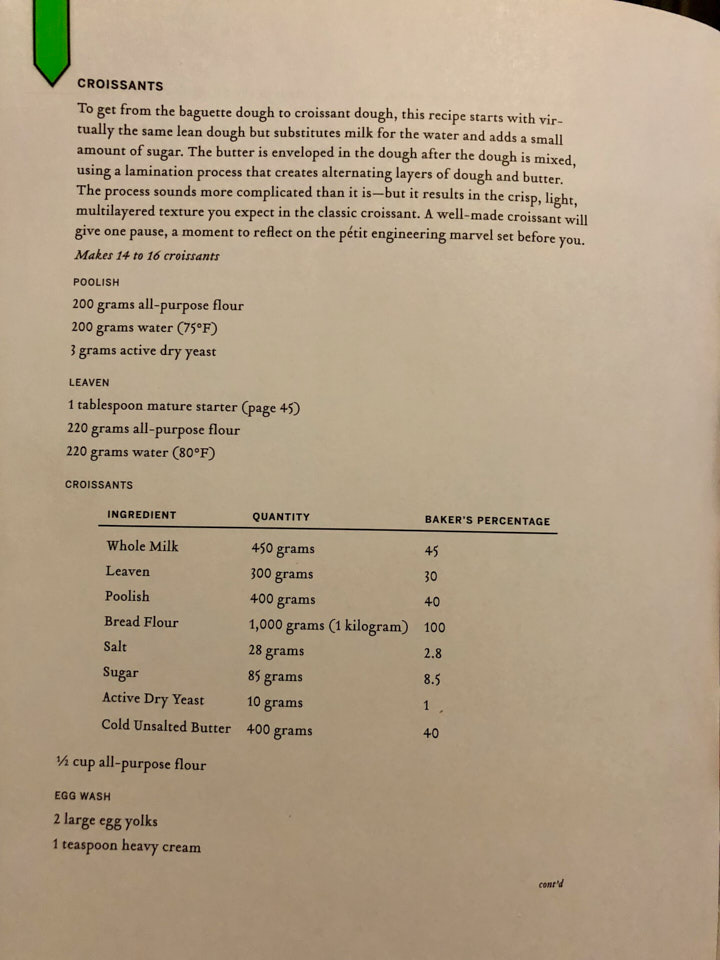
Jackie says
I found the answer to my question in the comments thank you!
Victor @ Taste of Artisan says
I see. I thought it was described in the recipes, but glad you found the answer to your question. Happy baking!
Alison Richman says
ok good. Everyone raved about them.
victor says
Not surprised. They are the best.
Alison Richman says
Hello again, when you say rotate the dough 90 degrees, do you mean to flip it over? The pic below the description shows the dough flipped over to the other side, but I had imagined merely rotating the square without flipping it. Thank you!
victor says
No flipping. Just rotate 90 degrees, roll out and fold again as you would a letter. The picture of the folded dough is taken after folding the second time. To put it more simply, you fold as a letter, roll out, and fold again.
Alison Richman says
Thank you! Did you realize your website is going down from time to time?
victor says
You are welcome. No, I did not. Thanks for letting me know, I will have my hosting support look into it.
Alison Richman says
They came out really good but huge! I noticed the dough was almost spongey and I almost couldn't roll the crescent at the end. Does that sound normal? Also the dough was pretty hard to roll by the second turn, and just a little butter was escaping. I felt like I might be doing the turns wrong so I'll try to find more demos online. Thanks again! Love your site.
victor says
What you describe is exactly what I've been experiencing. I never tweaked his recipe though as I love the final results - huge, flavorful, super tasty croissants with a lot of substance.
Dr.Lynn Williams says
I have an important question: In the original Tartine recipe for croissants it uses 625 G of butter for the laminate to 800 g of flour.. in the Tartine Bread book there is 1000 g flour to 400 g butter for the laminate---why is this?
Lastly, the Poolish that I made came out to weigh 385 g and the recipe called for 400 g. please answer these two questions for me. I am afraid after spending all day today folding and stuff that there is not enough butter as I used the recipe from your blog and the Tartine bread book. I am finishing and baking in the morning.
Sincerely,
Dr. Lynn
victor says
Sorry I could not get back you sooner - I was away all day yesterday. It's an interesting observation that in his two different books Mr. Robertson uses different butter to dough ratios. I just read through both chapters on croissants and did not find an explanation. In the second book, Tartine, he states that he is making his croissants the traditional way, observing traditional artisan standards. Having read and baked from all four of Tartine books, it's clear that he likes to experiment and constantly evolve his recipes. Is the one with higher butter ratio better? I don't know as I never tried it. I love the original recipe and don't want to change a thing. Also, I am not too thrilled about adding more fat calories to the croissants.
As to your second question, I've had the same problem. When you mix 200g each of water and flour, you are bound to end up with less than 400g of poolish in the end - some is left over on the spatula you mix the poolish with, and some will be left on the walls of the mixing bowl after you transfer it out. Some water will evaporate as well. What I do is compensate with leaven, which is also a 50/50 mix of water and flour, more or less. Or you can just add a 50/50 mix of water and flour to bring the total to 400g. Either will work just fine and help keep the total ratio of flour to water unchanged. Lately I've been making poolish with 220g water and 220g flour, same as the leaven, to avoid that problem.
All that said, I am quite sure that your croissants will turn out fabulous regardless if you put a little more or less of butter. A very small and insignificant reduction of poolish will not affect the results. Enjoy your croissants!
P.S. This post made me so hungry for croissants that I've decided to make a batch myself today;-)
Memoria says
What a gorgeous, laminated dough, and the croissants look amazing as well! I love making both, and after seeing your photos, I'm inspired to try out this recipe very soon. Great job!
Victor says
Let us know hot they turn out.
Terje says
They look magnificent! Just by looking at the photos it feels like I'm taken to Paris, eating these fluffy croissants at a summery street café. Never thought a recipe could make me crave food and travels at the same time!
Victor says
Ain't that the beauty of food blogging? 🙂
Jessie @ Straight to the Hips, Baby says
Oh my, just GORGEOUS! Really lovely! I wish I had a basket of these in front of me at this moment!
Victor says
I brought a basket of these to my work once, they were gone in a matter of minutes. They are dangerous 🙂
Thalia @ butter and brioche says
WOW these croissants are perfect! I regularly make croissants but use a slightly different approach and recipe. Your tartine recipe is definitely one I need to try out so I can compare the difference!
Victor says
Hi Thalia, thank you for the kind words. I'd love to see your recipe and especially photographs of your croissants. Your photography is one of the most creative and artful I have ever seen. Pain au Chocolat on your site is mouthwatering.